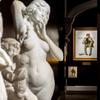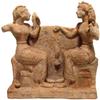The Secret Life of the Clergy: 19th-Century Cardinal Paintings
- May 28, 2021 10:39
The private lives of those who held prominent positions within the Catholic Church's hierarchy were a source of fascination for painters and the public alike in the second half of the 19th century. Academic genre scenes known as Cardinal paintings, or anti-clerical art, depicted the clergy in humorous, often unflattering situations to the delight of contemporary audiences. They quickly became a sought-after genre in their own right and remain just as beloved today.
Genre paintings were wildly popular at the grand Paris Salons of the 19th century, and satirical scenes of ecclesiastical life became a favorite subgenre among spectators. There was a high market demand for Cardinal paintings during the late 19th and early 20th centuries, evidenced by the sheer number of artists painting them. The majority of artists working in this genre, including its biggest names — François Brunery, Georges Croegaert, Andrea Landini and Jean Georges Vibert — hailed from predominantly Roman Catholic countries throughout Europe. Their popularity was so great that in 1886, American railroad magnate Collis Huntington paid an astonishing $25,000 for Vibert’s The Missionary’s Adventures, which now resides in the Metropolitan Museum of Art. But what caused this seemingly niche category of painting to appear when it did, and what made it resonate with the public so?
The public’s attitude towards the Church had undergone a major shift in the late 18th century and into the 19th, and the new prevailing mood was one of distrust and disdain for the clergy. Intense political upheavals had created a rift between the conservative Church and the liberal state, and the Industrial Revolution helped create an increasingly educated and informed public. Pope Pius IX convened the First Vatican Council in 1869, which produced the decree of Papal Infallibility, cementing the Pope's authority on all moral and religious matters — essentially alienating the institution even further.
In France, the Revolution had marked a turning point in the relations between the Catholic Church and the public. With the King overthrown, the people of France’s Third Republic now had the latitude to question the previously unquestionable authority of the Church. The relationship between Church and Crown had been broken, and a leader’s “divine right” to rule no longer held any weight. During the 1880s, several anticlerical international gatherings took place in Paris, leading to the establishment of the Fédération nationale de la libre pensée, a society that promoted humanist principles, campaigned against dogmatism and advocated for the separation of Church and states.
Also, the people’s contempt was aggravated simply by the Church’s immense wealth in all corners of Europe. As reverence was replaced with doubt, collectors and the public alike appreciated these voyeuristic views into the clergy’s all-too-human interior antics. The fact that such works satirizing the clergy would have been severely censured just a generation earlier made them all the more appealing to a European public that had grown discontent with the clergy’s hypocrisy and extreme excesses.
Despite this newfound scorn for the Catholic Church, Cardinal paintings were more about poking fun than creating real political dissension. They were, above all, entertaining.
Firstly, they are a feast for the eyes, painted in the academic style with rich detail and vibrant color. Brilliant “cardinal” red robes are set against lush interiors furnished with paintings, tapestries, ormolu furniture and the finest silver. The cardinals indulge in earthly pleasures, imbibing, enjoying lavish meals and making merry. They find themselves in ridiculous, compromising positions, such as a pet stealing away with a portion of their vestments as in François Brunery’s His Eminence's Monkey. They even frolic with kittens, like in Landini’s His Favorites. The paintings display a wonderful sense of realism, exhibiting the artists’ skill for rendering texture, light, shadow and detail with each and every brushstroke. Cardinal paintings are distinguished by their meticulous workmanship and beloved for their intrinsic humor and charm.
All of this is pleasing to the viewer’s senses, but the luxury of the setting juxtaposed against the frivolity of the clergy’s pastimes suggests a subtle criticism. Overall, the moral is implicit rather than explicit, and the criticism is more humorous than biting.
Andrea Landini, in particular, set himself apart within the genre with his vibrant works, both mirthful and full of character. A leading artist of these ecclesiastical genre scenes, he lavished his canvases with high technique, creating works of exquisite color and composition. His patrons were drawn to his magnificent cardinals not only for their irreverent subject matter, but also for his skilled treatment of it. His cardinals exist in surroundings that the public would have seen as too luxurious for a man of the cloth. It is clear that his subjects, despite the traditional vows of poverty customary in Christian doctrine, are living a rather pampered lifestyle. So, Landini takes them down a peg, skillfully depicting them with silly expressions, participating in frivolous activities and sometimes even against a backdrop of decidedly non-religious art featuring the human form as God made it.
Cardinal paintings provided the public an open window into the goings-on of the Catholic Church, and it mattered little that their contents were purely imagined. Though these clergymen are devoted to the Church, they are not themselves divine. They share the same human foibles as anyone — a comforting thought. The cardinals of these canvases are reduced to comedic figures, their condemnations of the public’s sins no longer worthy of much consideration.
About M.S. Rau:
M.S. Rau has spent more than 100 years earning the trust of discerning collectors worldwide. Located in the heart of New Orleans’ historic French Quarter, our peerless showroom houses one of the world’s most extensive and stunning collections of museum-quality fine art by artists such as Claude Monet and William Bouguereau, 18th- and 19th-century antiques and breathtaking jewelry, including rare colored diamonds.





















